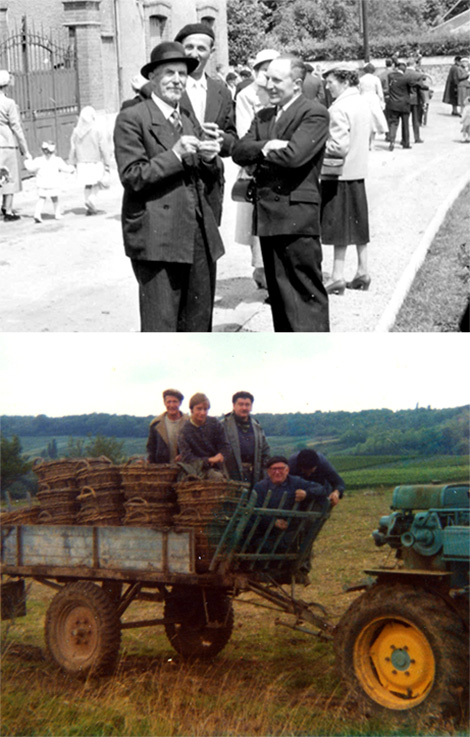The Piot-Sévillano family is the latest in a line of 10 generations of Champagne makers.
The family diversified and started growing Montmorency cherries (Following the phylloxera outbreak which ravaged 19th century vineyards). These were highly prized at the time in the Parisian markets.
The entire grape harvest was in those days sold to wine merchants who were the only people who transformed the grapes into champagne. It was Emile Piot (1880-1969), an expert in grafting plants, who dedicated the grounds to grape production.
By hand, he identified and selected the finest grafts, aiming for better and healthier grapes.
It was his son, Alexis Piot (1921-2008) and his wife Jeannine (1923-1967) who decided to start processing the grapes in 1954, when growers in the Champagne region were going through some difficult times.
Alexis Piot crafted his Brut Tradition champagne, which remains one of the family’s most popular wines, and quickly sold all of the 500 bottles he produced that year.


In 1975, the year of his daughter Isabelle and her husband Nicolas Sévillano’s wedding, Alexis produced 9000 bottles. Nicolas, with no background in the champagne industry, took professional classes and perfected the techniques handed down to him by his father-in-law.
Rosé champagne was added to the line in 1978, the Millésime in 1982, and finally our star champagne, the Prestige, entered the market in 1984.
At the same time, Nicolas and Isabelle were working hard to expand the site, add new vineyards, and regroup the olds. From the original 3 hectares cultivated by Alexis, the area grew to 7.5 hectares in just 25 years.
In 2006, the family produced 45,000 bottles.
In 2007, Nicolas and Isabelle handed the business to the next generation, their daughter Christine, who quits her job as a journalist. She took over the winery with her ex-husband Vincent, since moved to another operation.
After taking a series of professional courses, Christine started to invest in the renewal and modernization of the equipment. She bought a more environmentally friendly tractor, a Gyropalette system to replace the old Pupimatics, and even a heat pump to cool the tanks during the various steps in the wine-making process. During the 2011 harvest, she inaugurated a new building of almost 300m², where they set up the new pressing center with a new press, twice the size of the old one, and a huge cellar.
All of this new equipment enabled her to produce much more champagne and to expand into the international market.
She has already increased production up to 60,000 bottles to meet ever growing demand, and created more than 10 new champagnes in limited quantities for increasingly knowledgeable customers.
She implemented new agricultural techniques in order to preserve the unique terroir of her native village : strong reduction of treatments, zero weedkillers, use of organic fertilizers only, collection of rainwater to use them, protection of biodiversity. So many actions which allow to have the High Environmental Value label (HVE) in 2015 and Organic Agriculture label in 2023.
